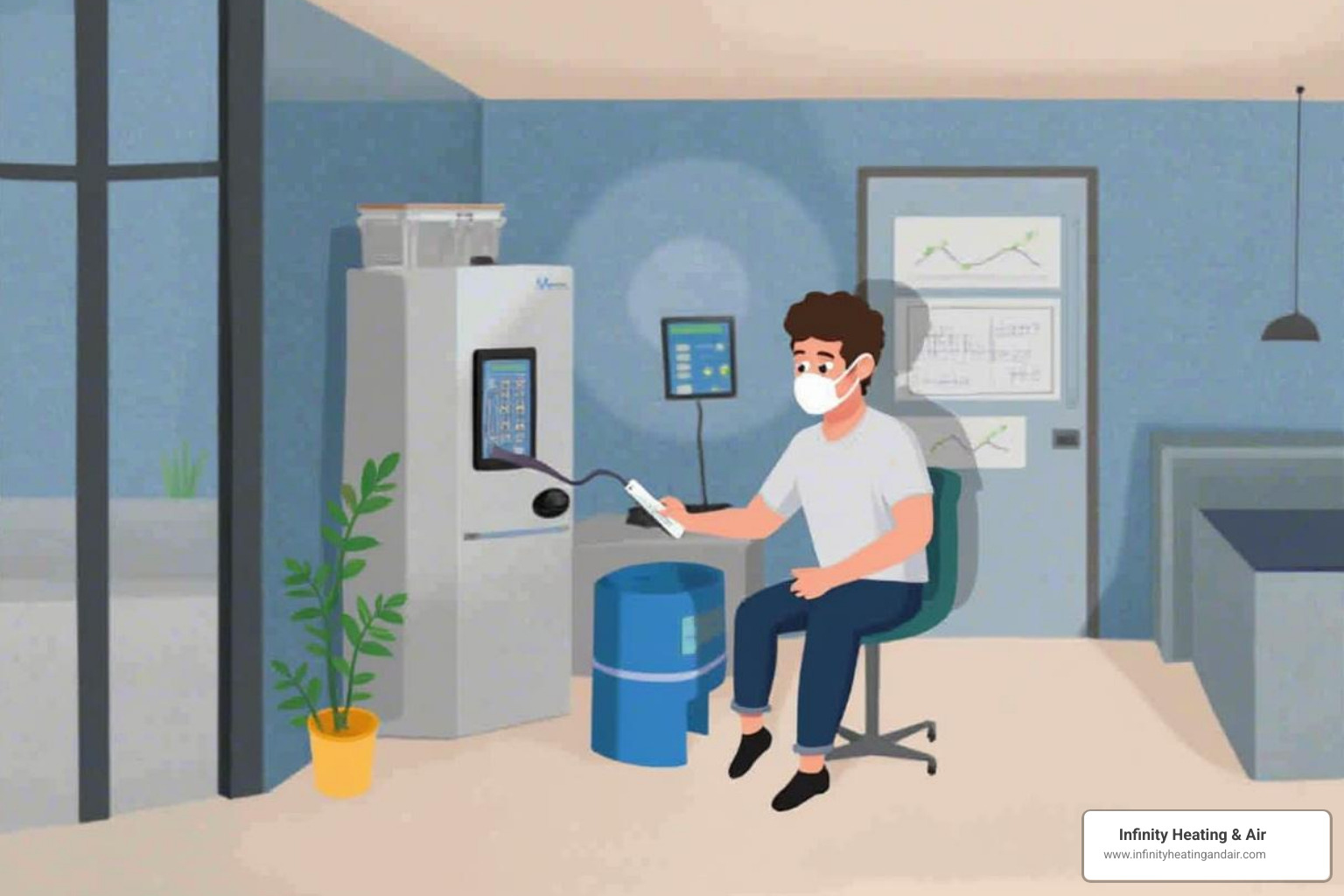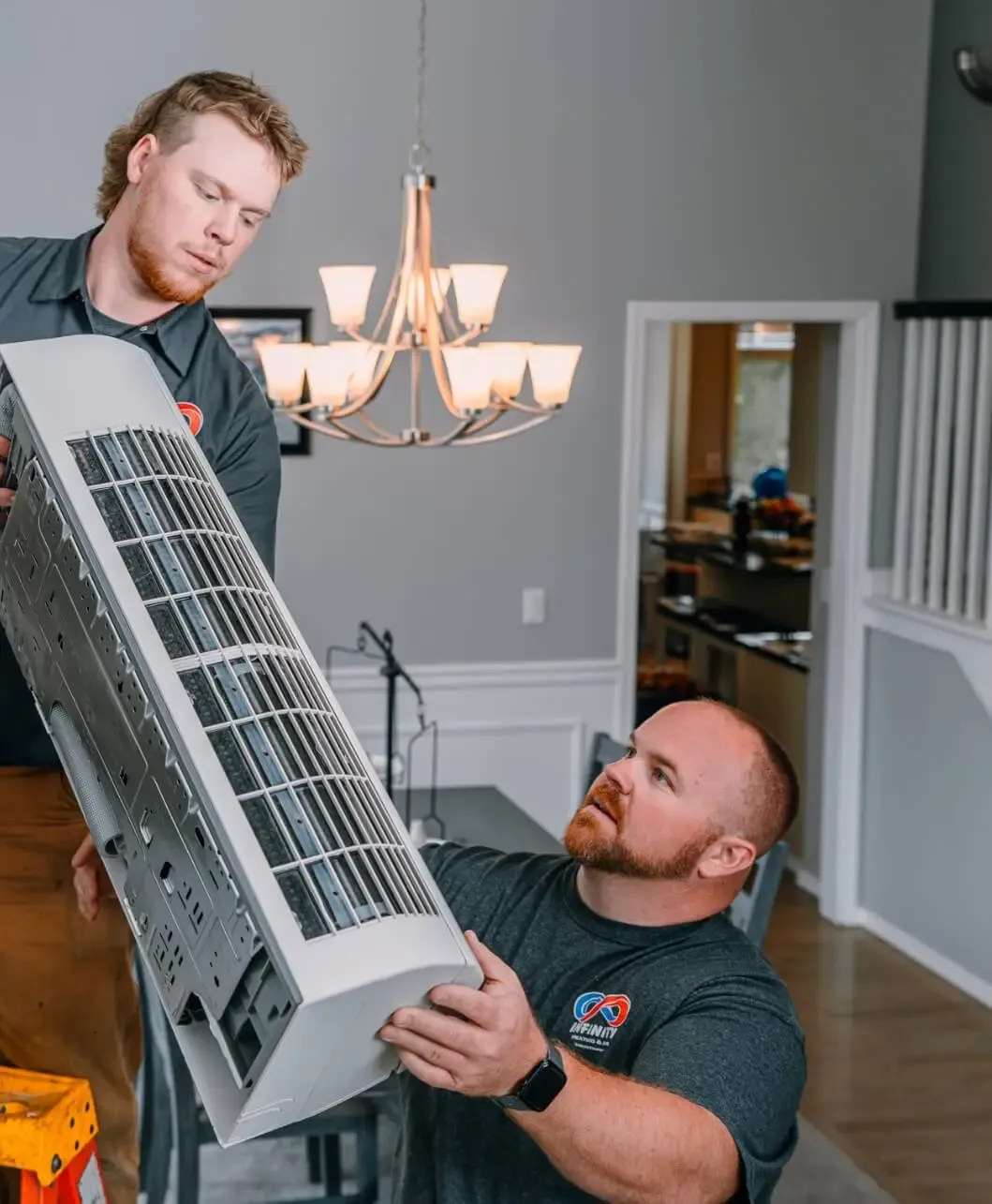
Is Your Air Clean? A Simple Guide to Air Quality Testing
Air quality testing by Infinity Heating & Air: Discover how to improve your home's air quality and identify common pollutants in 2025.
.webp)

Why Your Home’s Air Quality Matters More Than You Think
Are you looking to understand air quality testing for your home? You’re in the right place. To quickly answer your question, here are the primary ways to test your home’s air quality:
- DIY Monitors: Use continuous indoor air quality monitors to track common pollutants like VOCs, particulate matter, and CO2 in real-time.
- Specialized Test Kits: Employ specific kits for dangerous, odorless gases like radon and carbon monoxide. Simple mold kits are also available.
- Professional Services: Hire experts for comprehensive analysis, especially for complex issues like mold, asbestos, or when DIY results are concerning. They provide lab-verified results and detailed action plans.
You spend a lot of time at home. In fact, most of us spend about 90% of our lives indoors. And here’s a startling fact: the air inside your home can be up to five times more polluted than the air outside.
This isn’t just about comfort. Poor indoor air quality can seriously affect your health and overall well-being. It can trigger allergies, worsen asthma, and even contribute to long-term health issues. Globally, polluted air is a massive problem, impacting millions of lives and contributing to serious health risks for children.
Understanding what’s in your air is the first step toward creating a healthier, more comfortable living space for you and your family. This guide will walk you through everything you need to know about testing your home’s air quality.

The World Health Organization (WHO) reports that 90% of people worldwide breathe polluted air, and a staggering 93% of children under 18 are exposed to air pollution levels above what the WHO deems safe. This underscores why your home’s indoor air quality is so important. We believe that everyone deserves to breathe clean, healthy air, especially in the place where they find “endless comfort” – their home. For more on the basics of indoor air quality, you can refer to the Introduction to Indoor Air Quality provided by the EPA.
Signs You Might Have an Air Quality Problem
Your body is smart when it comes to warnings. When your home’s air quality is poor, you’ll often notice telltale signs that suggest it’s time for air quality testing.
Health Symptoms
Do you feel better after stepping outside, but symptoms return indoors? That’s a clear message. Common health signs include worsening allergies or asthma, especially if symptoms flare up primarily at home. Other indicators are unexplained headaches, dizziness, chronic fatigue, or persistent respiratory irritation like coughing, sneezing, a scratchy throat, or watery eyes.
These are what the EPA calls short-term health effects. What’s concerning is that prolonged exposure can lead to more serious long-term health risks, including respiratory diseases, heart conditions, and even certain cancers.
Home Indicators
Your house also provides clues about air quality problems. Pay attention to these signs:
- Excessive dust that reappears quickly after cleaning can indicate high levels of particulate matter.
- Lingering musty odors, especially in basements or bathrooms, often point to hidden mold or mildew.
- Visible mold or mildew as black, green, or white patches on walls, ceilings, or around windows are releasing spores into your air.
- High humidity and condensation on windows or damp surfaces create a breeding ground for mold and dust mites. Ideal indoor humidity is between 30-50%.
If these signs are familiar, air quality testing can help you find out what’s going on and how to fix it.
Common Indoor Pollutants and Their Dangers

Our homes should be safe havens, but unseen pollutants can compromise our health. Understanding these common indoor contaminants is key to creating a healthier environment.
First are Particulate Matter (PM2.5 and PM10). These are tiny bits of dust, dirt, and liquid in the air. PM2.5 particles are microscopic and can get deep into your lungs. They come from cooking, burning candles, fireplaces, and outdoor pollution. Exposure can irritate your nose and throat, worsen asthma, and contribute to heart and lung problems.
Next are Volatile Organic Compounds (VOCs). These are gases released from common household items like paint, cleaning products, air fresheners, new furniture, and carpets. Many VOCs are odorless. They can cause headaches, dizziness, nausea, and eye and throat irritation. The EPA provides more information on Volatile Organic Compounds’ Impact on Indoor Air Quality.
Radon is an invisible, odorless, and tasteless radioactive gas. It comes from the natural breakdown of uranium in the soil and can seep into homes through cracks in the foundation. Radon is the leading cause of lung cancer for non-smokers, making air quality testing for it essential. The EPA recommends testing every two years.
Mold thrives in damp, humid areas, releasing spores into the air. Inhaling these spores can cause allergic reactions, asthma attacks, and other respiratory issues. A musty smell is often the first clue, but mold can also hide behind walls or under floors.
Finally, Carbon Monoxide (CO) is a colorless, odorless gas produced by the incomplete burning of fuel in furnaces, gas stoves, water heaters, and fireplaces. High levels of CO can cause headaches, dizziness, confusion, and can be fatal. A working carbon monoxide detector is a non-negotiable safety device. The EPA has more details about carbon monoxide (CO) gas.
Uncovering these hidden dangers with air quality testing is the best way to ensure your home is a safe sanctuary.
Your Guide to Indoor Air Quality Testing
Now that you know why clean air is important, let’s cover the how. For air quality testing, you can either use DIY tools or hire professionals for a deep analysis. Each approach has its benefits.
FeatureDIY TestingProfessional TestingAccuracyVaries; consumer-grade sensors can be less preciseHigh; uses calibrated equipment and lab analysisScopeLimited to what your device/kit measures (e.g., CO2, VOCs, Radon)Comprehensive; identifies a wide range of pollutantsConvenienceHigh; immediate results for some pollutantsRequires scheduling, but hands-off for youCostLower upfront cost for monitors/kitsHigher upfront cost, but provides expert analysis and recommendationsInterpretationRequires you to research readings and implicationsExpert interpretation, detailed reports, and actionable adviceAction PlanSelf-guided based on your researchProvided by experts, customized for your homePeace of MindGood for general awarenessComprehensive and reassuring for serious concerns
DIY Air Quality Testing: What You Can Do Today
Starting with DIY air quality testing is a great first step. It’s accessible, affordable, and provides valuable insights into your daily environment.
Indoor Air Quality Monitors are like 24/7 air detectives for your home. These devices use sensors to continuously track pollutants, displaying real-time data on the unit or a smartphone app. They typically detect:
- Volatile Organic Compounds (VOCs): Indicates chemical fumes.
- Particulate Matter (PM2.5): Measures fine dust, pollen, and other particles.
- Carbon Dioxide (CO2): High levels suggest poor ventilation.
For best results, place your monitor in a high-traffic area like the living room or bedroom, at breathing height. You can Learn more about correct placement here..
Beyond monitors, you can use specific test kits for certain dangers.
- Carbon Monoxide (CO) Detectors: These are essential safety devices, not just one-time tests. CO is an odorless, tasteless, and invisible gas often called the “silent killer“. Every home needs detectors on each floor, especially near sleeping areas. If the alarm sounds, evacuate everyone immediately and call 9-1-1. The EPA has more on carbon monoxide (CO) gas.
- Radon Test Kits: Since radon is also undetectable by human senses, a test kit is the only way to know if it’s in your home. You place a device in your home for a set period and mail it to a lab for analysis. The EPA strongly recommends radon testing, especially if you live in a high-risk area, which you can check on the EPA’s Map of Radon Zones. Find kits and more info at epa.gov.
- Mold Test Kits: If you suspect mold due to dampness or leaks, these kits allow you to swab an area and test for mold right at home or send it to a lab. While they confirm mold’s presence, they may not identify the type or severity. For significant mold problems, a professional assessment is the best next step.
The Benefits of Professional Air Quality Testing
While DIY testing is a great start, professional services are necessary for complex issues or for complete peace of mind.
Professional air quality testing provides comprehensive analysis using calibrated, lab-grade equipment. Our experts can identify a wider range of pollutants—like specific molds, asbestos, lead, and bacteria—that consumer devices might miss. We also excel at finding hidden trouble spots, tracing pollutants to their source, whether it’s in your HVAC system or behind walls.
After testing, we don’t just give you data; we provide a clear-cut action plan with step-by-step recommendations custom to your home. This expert guidance ensures problems are resolved effectively, giving you total peace of mind.
Here at Infinity Heating & Air, our team is passionate about creating healthy living environments for our neighbors in Northwest Washington. We understand the local air quality challenges and are equipped with the right solutions to help you achieve “endless comfort” and breathe easier.
From Testing to Action: How to Improve Your Indoor Air
Once air quality testing reveals what’s in your home’s air, the next step is taking action. Improving indoor air quality often involves a combination of effective strategies.

A simple yet powerful strategy is ventilation. When outdoor air is clean, open your windows and doors for a few minutes daily to flush out indoor pollutants. Use kitchen and bathroom exhaust fans during and after cooking or showering to vent moisture and odors directly outside.
Your HVAC system is central to air circulation and purification. Regularly changing or cleaning air filters is a critical task. For better results, upgrade to high-efficiency air filters with a higher MERV rating to capture smaller particles like dust, pollen, and mold spores. For an even higher level of protection, a whole-home air purifier integrated with your HVAC system can capture and neutralize a wide range of contaminants. The EPA offers more helpful guidance on air cleaners and filters for your home.
Source control means preventing pollutants from getting into your air in the first place. Choose “low-VOC” or “no-VOC” products for painting and cleaning. Regular cleaning, including dusting and vacuuming with a HEPA-filtered vacuum, reduces particulate matter, dust mites, and pet dander. Always avoid smoking indoors and promptly fix any water leaks to prevent mold growth.
Finally, focus on humidity control. The ideal indoor humidity level is between 30-50%. A dehumidifier can prevent mold and dust mites in damp areas, while a humidifier can add necessary moisture during dry winter months to prevent respiratory irritation.
By implementing these strategies based on your air quality testing results, you can create a healthier and more comfortable living space.
Frequently Asked Questions about Air Quality Testing
Homeowners often have questions about their air quality. Here are answers to some of the most common ones.
How often should I test my home’s air quality?
The frequency of air quality testing depends on several factors.
- For radon, the EPA suggests testing every two years, or after major renovations.
- For general pollutants like VOCs and PM2.5, continuous monitoring with a home device is ideal for tracking daily changes and identifying trends from activities like cooking.
- It’s also wise to test after major home changes, such as renovations or water damage from a leak or flood, to check for hidden contaminants like mold.
- Finally, if your family experiences new or worsening health symptoms that improve when you leave the house, it’s a clear sign to test your air.
Can indoor plants really purify the air?
While indoor plants like the Spider Plant (pet-safe) or Peace Lily (toxic to pets) are known to absorb some airborne toxins, their overall impact on purifying your home’s air is minimal. They are a wonderful aesthetic addition but are not a substitute for proper ventilation or a high-quality air filtration system. If you have pets, always check if a plant is safe before bringing it home! You can find more information on plants that improve air quality and their impact.
What is the Air Quality Index (AQI)?
The Air Quality Index (AQI) is a tool used to report daily outdoor air quality. You can find your local AQI by checking the Air Quality Index on websites like AirNow.gov.
The AQI tracks five major pollutants and uses a simple color-coded system to communicate health risks, from Green (Good) to Maroon (Hazardous). Since outdoor air affects indoor air, knowing the local AQI helps you decide when it’s a good day to open windows for ventilation or when you should keep them closed and rely on your indoor air purification system.
At Infinity Heating & Air, we believe a healthy home is a happy home, which includes total property well-being. For instance, maintaining waste management systems with services like Septic Pumping or Grease Trap Services also contributes to a healthier living environment. Comprehensive property care can even include Commercial Septic Pumping or Portable Toilet Rentals. We’re here to help you achieve “endless comfort” in every sense of the word.
Conclusion: Breathe Easier with Confidence
It’s clear that the air we breathe inside our homes plays a huge part in our health and how comfortable we feel every day. Since most of us spend so much time indoors, making sure your home’s air is clean and healthy isn’t just a nice-to-have anymore—it’s a must-have. From learning to spot the subtle signs of poor air quality to understanding those sneaky pollutants like VOCs and radon, air quality testing is the best first step any homeowner can take. It’s about being proactive for your family’s health.
Whether you decide to start with a simple DIY monitor or you choose the deep insights you get from professional testing, your main goal is always the same: to create a home that’s healthier and more comfortable for everyone you love. Here at Infinity Heating & Air, we’re truly dedicated to helping you find that “endless comfort” right where you live.
We’re here to offer a thorough assessment and expert solutions, designed just for you, so you can achieve that feeling of endless comfort. Let us help you breathe easier, with complete confidence, in your Northwest Washington home. When you’re ready to take the next step towards a healthier home, simply Contact Us.

Endless Comfort
Starts Here
Our expert technicians are ready to serve you and your home.





